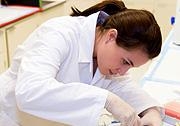Breast cancer drugs: $21 million wasted
UNSW researchers have highlighted concerns about the clinical use and cost benefits of one of Australia's most expensive publicly funded medicines, the anti-breast cancer drug Herceptin.
UNSW researchers have highlighted concerns about the clinical use and cost benefits of one of Australia's most expensive publicly funded medicines, the anti-breast cancer drug Herceptin.

UNSW researchers have highlighted concerns about the clinical use and cost benefits of one of Australia's most expensive publicly-funded medicines, the anti-breast cancer drug Herceptin.
The world-first study has appeared in the Journal of Clinical Oncology. It looks at all women with HER2 positive metastatic breast cancer who received Herceptin in Australia between December 2001 and March 2005.
Researchers Dr Sallie-Anne Pearson, Ms Clare Ringland and Professor Robyn Ward found use of the drug in clinical practice differed from the way it was used in clinical trials. The drug was used for longer periods in real-life situations, often in conjunction with chemotherapy drugs which are not approved for use with Herceptin.
There was also a surprisingly low rate of monitoring for one of the drug's established side effects - cardiac dysfunction and congestive heart failure.
At a production cost of $55,000 per patient per year, Herceptin is provided free to Australian patients through a special tax-payer funded program outside the Pharmaceutical Benefits Scheme (PBS).
However, data showed significant wastage associated with the dosage and packaging of the drug. Some 20,667 vials of Herceptin were discarded in the 40-month-long study period, almost a quarter of the total dispensed, and at a cost of $21.1 million.
The researchers say the findings raise important questions about administration of the drug, its clinical use, and the issues of cardiac monitoring and drug wastage.
Professor Ward says the drug has made a great contribution to the fight against cancer.
"It's been a breakthrough drug in many ways, but our study shows that there is room for improvement in the way that we are using it to treat women with breast cancer. Our findings also show how important it is to monitor prescribing patterns, especially for very expensive or new drugs".